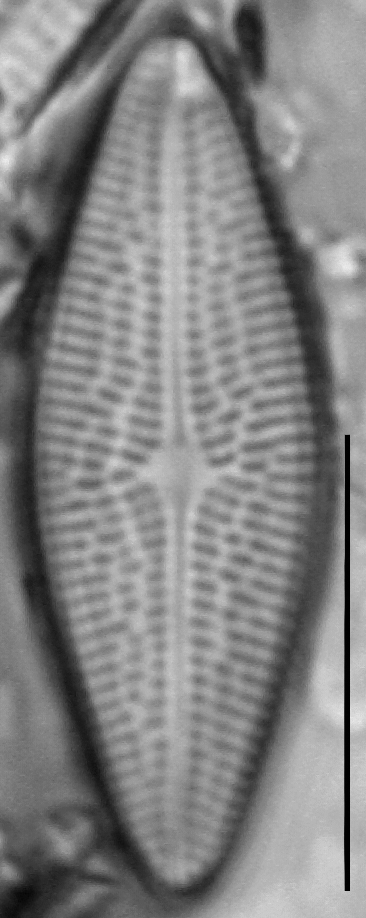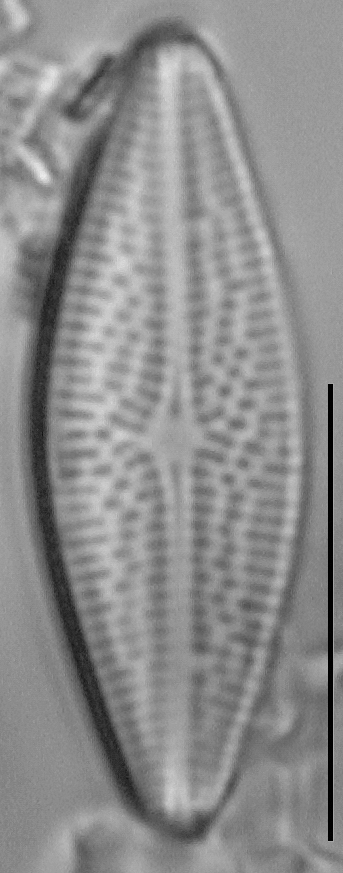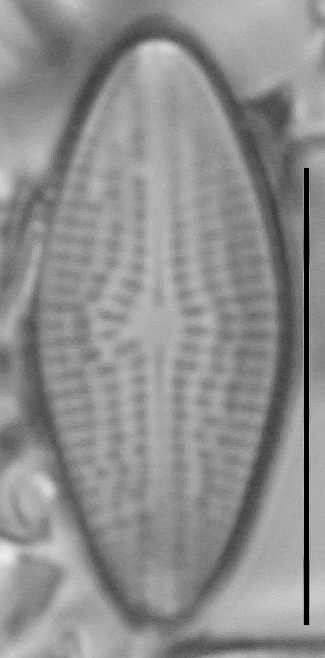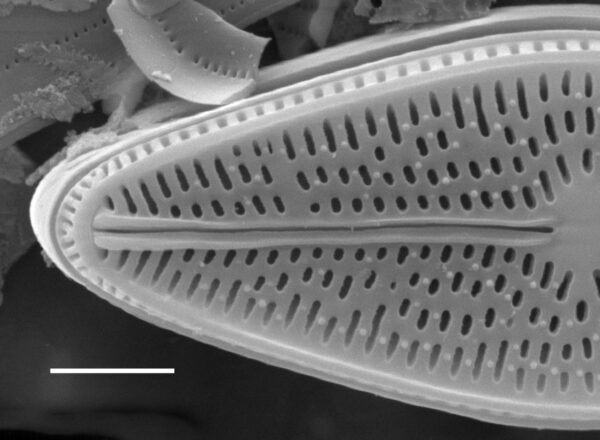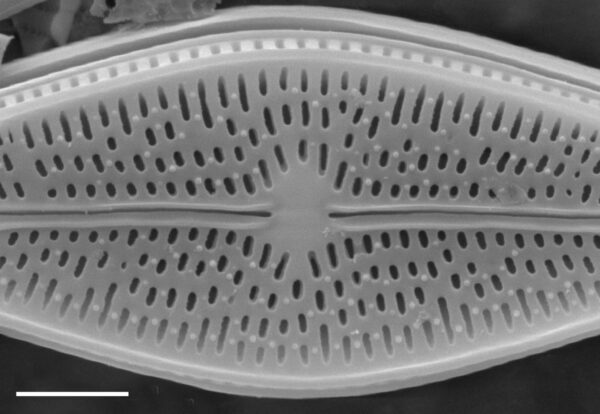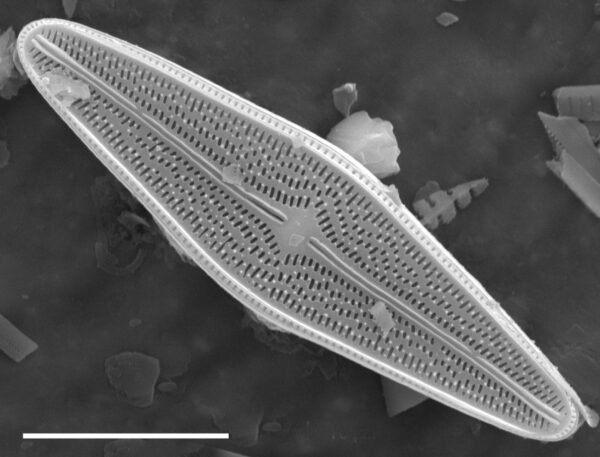Brachysira brebissonii
-
Category
-
Length Range11-36 µm
-
Width Range4-8 µm
-
Striae in 10 µm26-35
-
SynonymsAnomoeoneis serians var. brachysira (Bréb. ex. Kützing) Hustedt
-
ContributorPaul Hamilton - Dec 2010
-
ReviewerSarah Spaulding - Feb 2011
Identification
Description
Valves are small, rhombic-lanceolate to elliptical-lanceolate with narrow rounded apices. Striae are weakly radiate from center to apex. The axial area is narrow and straight. The raphe is positioned within two ribs that lie on the external face of the valve. The ribs terminate at the edge of the central area and the apices. The raphe is filiform and straight, with expanded drop-like proximal fissures and T-shaped distal fissures. Areolae are typically elongate. The striae are interrupted by hyaline areas, creating a “wave-like” appearance of the striae. Central area is small, circular to slightly oval. Small papillae (silica nodules) are often scattered across the external valve face, visible in SEM. A thickened rib is present along the valve margin and apex, separating the valve face from the mantle. Striae on the mantle are uniseriate and aligned with striae on the valve face. In SEM, the internal proximal raphe fissures are unilaterally deflected. The distal fissures are bounded by small helictoglossa. Areolae are covered internally with flat hymenes.
Autecology
Brachysira brebissonii was widely distributed across North America in acidic waterbodies. In studies along the Altantic coastal plain this taxon was observed in ponds that were moderately acidic and oligotrophic to mesotrophic. Despite being widespread, it was usually found in low numbers. pH and TP optima (average weighted means, AWM) from four studies (Siver & Hamilton, 2011; Siver et al. 2005; Camburn & Charles 2000; Gaiser & Johansen 2000) range from 4.7-5.8 and 5.7-13.2 for pH and TP (µg/L) respectively.
-
Size Range, µm3
-
Motility
-
Attachment
-
Habitat
-
BCG
-
Waterbody
-
Distribution
- Learn more about this
Original Description
- N: brachysira Bréb. (T. V. F. 11. c. d. e.) unterscheidet sich von der N. aponica nicht wesentlich, sie bleibt nach der Theilung nur länger als die typische Form verbunden und erscheint dann eine Zeit lang in Kurzen Bändern, wie das auch öfters bei der N. serians der Fall ist. De Brébisson hat sie bei Falaise beobachet.
-
BasionymNavicula aponica var. brachysira
-
AuthorBréb. ex. Kütz. 1849
Citations & Links
Citations
-
Publication Link: 10.1080/0269249X.2000.9705487
Links
-
Index Nominum Algarum
Cite This Page
Hamilton, P. (2010). Brachysira brebissonii. In Diatoms of North America. Retrieved November 21, 2024, from https://diatoms.org/species/brachysira_brebissonii
Responses
The 15 response plots show an environmental variable (x axis) against the relative abundance (y axis) of Brachysira brebissonii from all the stream reaches where it was present. Note that the relative abundance scale is the same on each plot. Explanation of each environmental variable and units are as follows:
ELEVATION = stream reach elevation (meters)
STRAHLER = distribution plot of the Strahler Stream Order
SLOPE = stream reach gradient (degrees)
W1_HALL = an index that is a measure of streamside (riparian) human activity that ranges from 0 - 10, with a value of 0 indicating of minimal disturbance to a value of 10 indicating severe disturbance.
PHSTVL = pH measured in a sealed syringe sample (pH units)
log_COND = log concentration of specific conductivity (µS/cm)
log_PTL = log concentration of total phosphorus (µg/L)
log_NO3 = log concentration of nitrate (µeq/L)
log_DOC = log concentration of dissolved organic carbon (mg/L)
log_SIO2 = log concentration of silicon (mg/L)
log_NA = log concentration of sodium (µeq/L)
log_HCO3 = log concentration of the bicarbonate ion (µeq/L)
EMBED = percent of the stream substrate that is embedded by sand and fine sediment
log_TURBIDITY = log of turbidity, a measure of cloudiness of water, in nephelometric turbidity units (NTU).
DISTOT = an index of total human disturbance in the watershed that ranges from 1 - 100, with a value of 0 indicating of minimal disturbance to a value of 100 indicating severe disturbance.
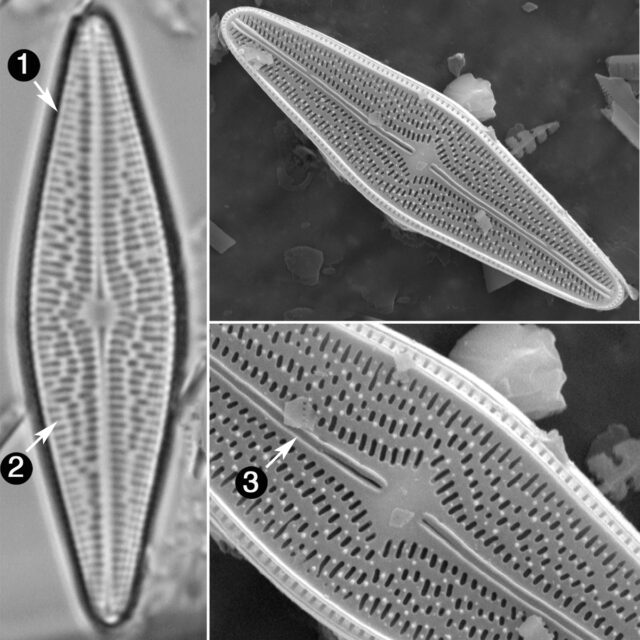
Brachysira brebissonii
- Valves rhombic-lanceolate to elliptical-lanceolate
- Striae weakly radiate
- Raphe positioned within two longitudinal ribs
- Papillae may be present or absent
Valves are rhombic-lanceolate to elliptical-lanceolate in valve outline. Striae are weakly radiate across the entire valve face. The raphe is positioned within two external ribs on the valve face. The ribs terminate at the edge of the central area and the apices. The areolae are irregular in shape and spacing, creating a “wave-like”...
 Diatoms of North America
Diatoms of North America



